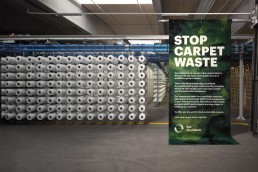Ege Carpets launches new sustainability initiative
Ege Carpets has launched its new sustainability initiative – a take-back system where used carpets are collected and recycled into new materials.
Today, only 1-3% of all carpets in Europe are reused or recycled, while the rest is sent for incineration or to a landfill. Herning-based carpet manufacturer Ege Carpets has launched Ege CircleBack with the intention of improving this statistic.
When an Ege CircleBack carpet has reached the end of its use, it is collected and cut into smaller pieces, which are sorted into components that are transformed into new materials, such as yarn for new carpets. Afterwards, Ege Carpets calculate the total CO2 reduction for the customer, who is able to see results documented in a certificate. With the new system, the carpet’s CO2 emissions during the elimination phase are reduced by up to 60%.
The initiative will first be implemented on Ege Carpets’ ten best-selling wall-to-wall collections in Europe, with the ultimate goal being for all the manufacturer’s carpets to be subject to a take-back or recycling system by 2030.
Ege CircleBack has been developed in collaboration with yarn manufacturer Aquafil, who recycles fibre material in the carpets to produce new nylon yarn.
“We live in a world where far too many products are destroyed directly after use, even though the materials can still be used for many other purposes,” says Rune Stephansen, CEO of Ege Carpets. “Therefore, we’re looking into how we as a company can utilise the resources in the best way and as much as possible. With Ege CircleBack, we optimise both our own choices of raw materials so that they’re more recycled or recyclable, and make sure that their longevity is lengthened as much as possible.
“Additionally, documentation is always good when you want to work actively with sustainability. Therefore, we’ve chosen to include certificates as part of the take-back system, which our customers can use as documentation in their carbon accounting in the sustainability report.”
Related Posts
25 August 2023
RH unveils 2023 Interiors Collection
16 August 2023




